Geometric sequences, also known as geometric progressions, are a fundamental concept in mathematics, forming the basis for more advanced topics and appearing in various real-world applications. Understanding geometric sequences is crucial for students at various levels, from secondary school to higher education. This comprehensive guide, brought to you by learns.edu.vn in collaboration with Third Space Learning, will explore geometric sequences in detail, covering everything from the basic definition to advanced problem-solving techniques. Whether you’re a student struggling with sequences or looking to deepen your understanding, this resource is designed to provide clear explanations, practical examples, and effective learning strategies.
What are Geometric Sequences?
A geometric sequence is a series of numbers where each term after the first is found by multiplying the previous one by a fixed, non-zero number called the common ratio. This consistent multiplication factor is what defines a geometric sequence and distinguishes it from other types of sequences, such as arithmetic sequences where a common difference is added to each term.
In simpler terms, to get from one term to the next in a geometric sequence, you always multiply (or divide, which is just multiplying by a fraction) by the same number.
Let’s look at some examples to illustrate this concept:
| First Term | Term-to-Term Rule | First 5 Terms |
|---|---|---|
| 3 | Multiply by 3 | 3, 9, 27, 81, 243, … |
| 5 | Multiply by 2 | 5, 10, 20, 40, 80, … |
| -12 | Divide by 2 | -12, -6, -3, -1.5, -0.75, … |
| 0.8 | Multiply by 5 | 0.8, 4, 20, 100, 500, … |
| 1/2 | Divide by 4 | 1/2, 1/8, 1/32, 1/128, 1/512 … |
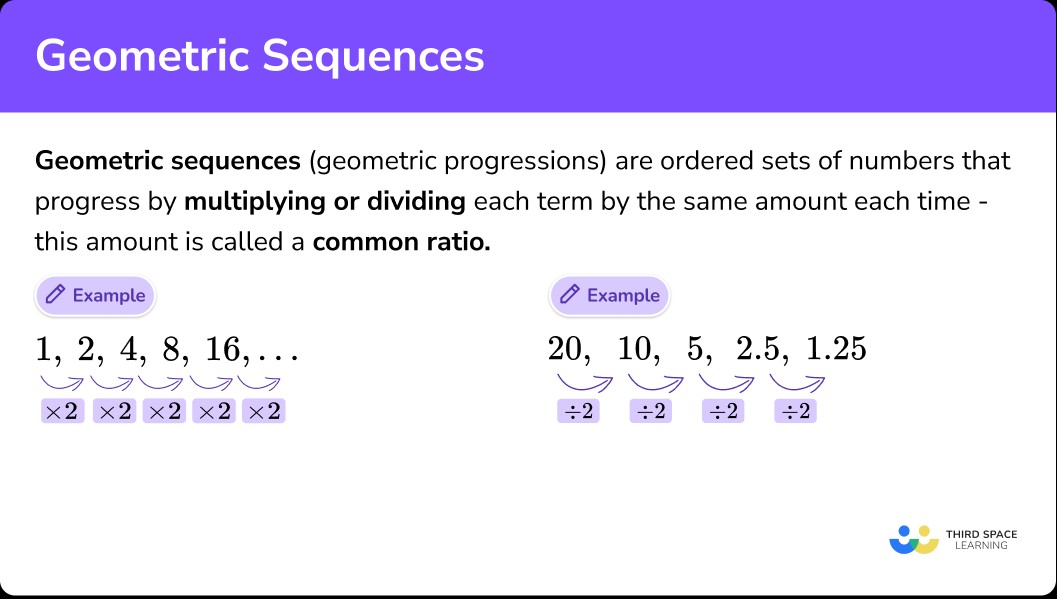
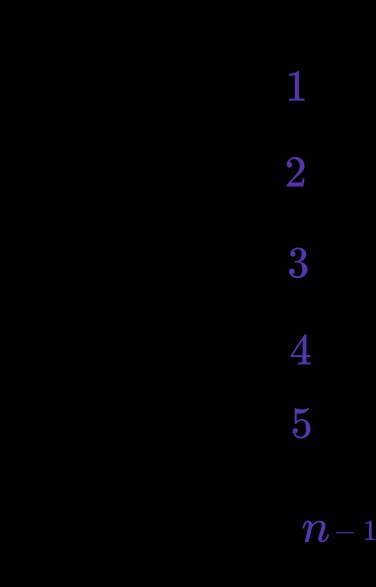
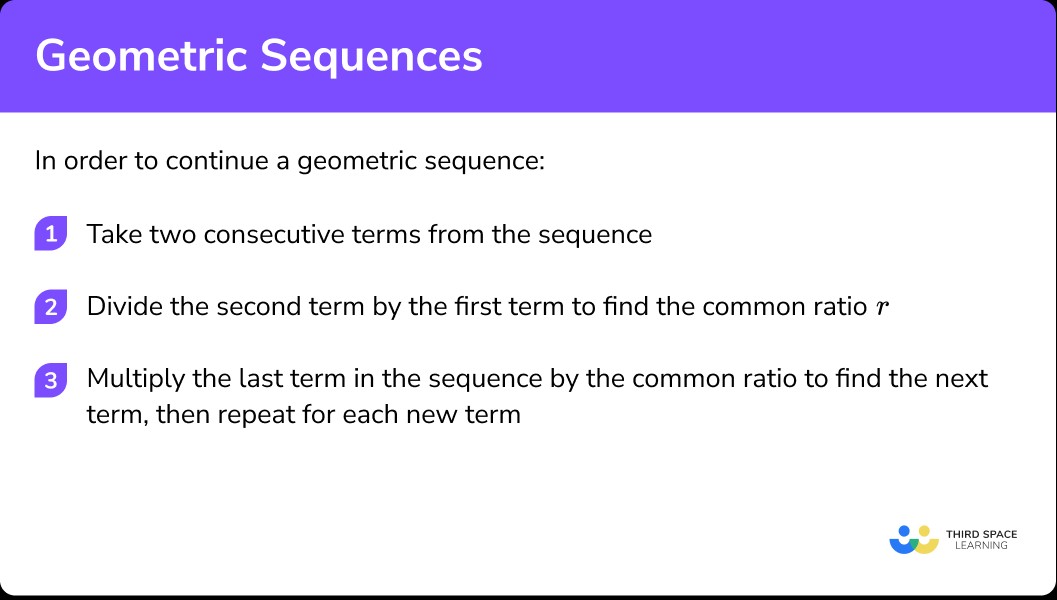
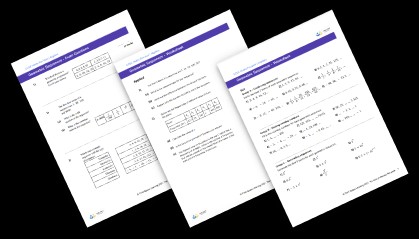
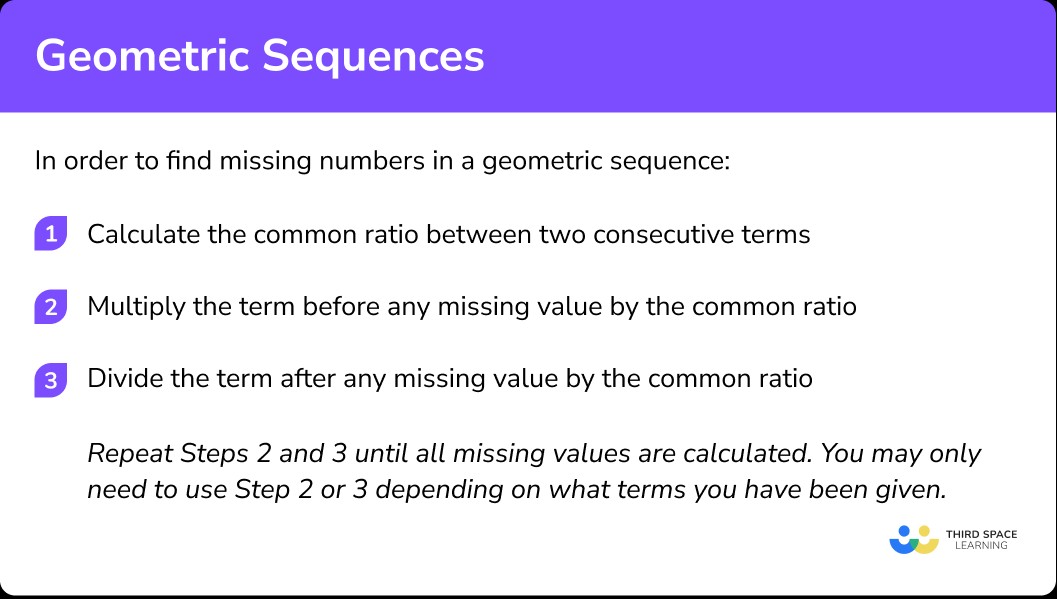
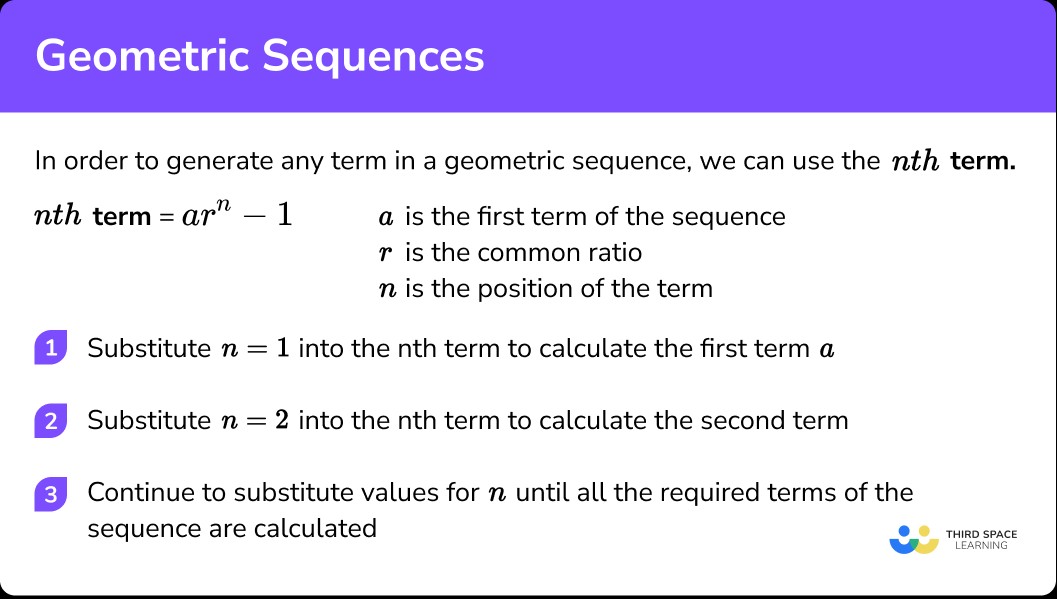
In each of these examples, you can see a consistent ratio between consecutive terms. For instance, in the first sequence (3, 9, 27, 81, 243…), the common ratio is 3 because 9/3 = 3, 27/9 = 3, and so on. Similarly, for the sequence (5, 10, 20, 40, 80…), the common ratio is 2.
Understanding the common ratio is key to working with geometric sequences. It allows you to predict future terms, find missing terms, and even derive formulas to describe the entire sequence.
Geometric Sequence Formula Explained
To formally represent geometric sequences and work with them more efficiently, mathematicians use a general formula. The formula for the nth term (often denoted as an) of a geometric sequence is:
*an = a1 r(n-1)**
Where:
- an is the nth term in the sequence (the term we want to find).
- a1 is the first term of the sequence.
- n is the position of the term in the sequence (e.g., 1 for the first term, 2 for the second term, etc.).
- r is the common ratio.
Let’s break down how this formula works using an example. Consider the geometric sequence: 5, 10, 20, 40, …
Here, the first term (a1) is 5, and the common ratio (r) is 2 (since 10/5 = 2). Let’s see how the formula generates the terms:
- For the 1st term (n=1): a1 = 5 2(1-1) = 5 20 = 5 * 1 = 5
- For the 2nd term (n=2): a2 = 5 2(2-1) = 5 21 = 5 * 2 = 10
- For the 3rd term (n=3): a3 = 5 2(3-1) = 5 22 = 5 * 4 = 20
As you can see, the formula accurately generates the terms of the sequence. This formula is incredibly useful because it allows you to find any term in a geometric sequence without having to calculate all the preceding terms. For example, you could easily find the 100th term of the sequence using this formula.
Continuing a Geometric Sequence: Step-by-Step
One of the most basic tasks when working with geometric sequences is to continue the sequence, meaning to find the next terms after a given set of terms. To do this, you need to identify the common ratio and then use it to extend the sequence. Here’s a step-by-step method:
- Identify two consecutive terms: Choose any two terms that are next to each other in the sequence.
- Calculate the common ratio (r): Divide the second term by the first term. This will give you the common ratio.
- Multiply to find the next term: Multiply the last known term in the sequence by the common ratio (r) to get the next term.
- Repeat: Continue multiplying each subsequent term by the common ratio to find further terms in the sequence.
Let’s illustrate this with an example. Suppose you have the geometric sequence: 2, 6, 18, 54, … and you want to find the next three terms.
- Consecutive terms: Let’s take 18 and 54.
- Common ratio: r = 54 / 18 = 3.
- Next term: 54 * 3 = 162.
- Repeat: 162 3 = 486, and 486 3 = 1458.
Therefore, the next three terms in the sequence are 162, 486, and 1458, and the sequence becomes: 2, 6, 18, 54, 162, 486, 1458, …
This method works for any geometric sequence, regardless of whether the common ratio is a whole number, fraction, decimal, or negative number.
To further practice and solidify your understanding of geometric sequences, consider using geometric sequence worksheets. These worksheets, like the one offered by Third Space Learning, provide a variety of questions ranging from basic to more challenging, helping you develop fluency and problem-solving skills in this area.
Examples of Continuing Geometric Sequences
Let’s work through some examples to practice continuing geometric sequences with different types of numbers.
Example 1: Continuing a geometric sequence with whole numbers
Calculate the next three terms for the geometric progression 1, 2, 4, 8, 16, …
- Take two consecutive terms: Let’s use 4 and 8.
- Find the common ratio: r = 8 ÷ 4 = 2.
- Multiply to extend:
- 16 * 2 = 32
- 32 * 2 = 64
- 64 * 2 = 128
The next three terms are 32, 64, and 128.
Example 2: Continuing a geometric sequence with negative numbers
Calculate the next three terms for the sequence -2, -10, -50, -250, -1250, …
- Consecutive terms: Let’s use -10 and -50.
- Common ratio: r = -50 ÷ -10 = 5.
- Multiply to extend:
- -1250 * 5 = -6250
- -6250 * 5 = -31250
- -31250 * 5 = -156250
The next three terms are -6250, -31250, and -156250.
Example 3: Continuing a geometric sequence with decimals
Calculate the next three terms for the sequence 100, 10, 1, 0.1, 0.01, …
- Consecutive terms: Let’s use 0.1 and 0.01.
- Common ratio: r = 0.01 ÷ 0.1 = 0.1.
- Multiply to extend:
- 0.01 * 0.1 = 0.001
- 0.001 * 0.1 = 0.0001
- 0.0001 * 0.1 = 0.00001
The next three terms are 0.001, 0.0001, and 0.00001.
Example 4: Continuing a geometric sequence with fractions
Calculate the next three terms for the sequence 10, 5, 2½, 1¼, 5/8, …
- Consecutive terms: Let’s use 5 and 2½.
- Common ratio: r = 2½ ÷ 5 = (5/2) ÷ 5 = 1/2.
- Multiply to extend:
- 5/8 * 1/2 = 5/16
- 5/16 * 1/2 = 5/32
- 5/32 * 1/2 = 5/64
The next three terms are 5/16, 5/32, and 5/64.
Practice Questions: Continue the Sequence
Test your understanding by answering these practice questions.
-
Write the next three terms of the sequence 0.5, 5, 50, 500, …
- a) 1000, 5000, 10000
- b) 950, 1400, 1850
- c) 5000, 50000, 500000
- d) 550, 555, 560
Correct Answer: c) 5000, 50000, 500000
-
Write the next three terms of the sequence 0.04, 0.2, 1, 5, 25, …
- a) 50, 100, 200
- b) 125, 625, 3125
- c) 50, 1000, 20000
- d) 12.5, 6.25, 3.125
Correct Answer: b) 125, 625, 3125
-
Calculate the next 3 terms of the sequence -1, -3, -9, -27, -81, …
- a) 243, 729, 2187
- b) -243, -729, -2187
- c) 243, -729, 2187
- d) -27, -9, -3
Correct Answer: b) -243, -729, -2187
-
By finding the common ratio, state the next 3 terms of the sequence 640, 160, 40, 10, 2.5.
- a) 0.625, 0.15625, 0.0390625
- b) 1.25, 0.625, 0.3125
- c) 10, 40, 160
- d) 0.25, 0.025, 0.0025
Correct Answer: a) 0.625, 0.15625, 0.0390625
-
Work out the common ratio and therefore the next three terms in the sequence 36, 12, 4, 4/3, 4/9, …
- a) 12/9, 36/9, 108/9
- b) 12/27, 36/81, 108/243
- c) 4/12, 4/15, 4/18
- d) 4/27, 4/81, 4/243
Correct Answer: d) 4/27, 4/81, 4/243
-
Find the common ratio and hence calculate the next three terms of the sequence 1, -1, 1, -1, 1, …
- a) 1, 1, 1
- b) -1, -1, -1
- c) 1, -1, 1
- d) -1, 1, -1
Correct Answer: d) -1, 1, -1
Finding Missing Numbers in a Geometric Sequence
Sometimes, you might encounter a geometric sequence with missing terms. To find these missing terms, you can still use the common ratio, but you’ll need to work both forwards and backwards in the sequence. Here’s the method:
- Calculate the common ratio: If you have at least two consecutive terms that are known, calculate the common ratio by dividing the second term by the first.
- Multiply to fill in forward gaps: If there’s a missing term after a known term, multiply the known term by the common ratio to find the missing term.
- Divide to fill in backward gaps: If there’s a missing term before a known term, divide the known term by the common ratio to find the missing term.
Repeat steps 2 and 3 as needed until all missing terms are found.
Examples of Finding Missing Numbers
Let’s look at some examples of how to find missing numbers in geometric sequences.
Example 5: Finding missing numbers with consecutive known terms
Fill in the missing terms in the sequence 7, 14, …, …, 112.
- Common ratio: r = 14 ÷ 7 = 2.
- Multiply forward: 14 * 2 = 28 (first missing term).
- Multiply forward again: 28 * 2 = 56 (second missing term).
The missing terms are 28 and 56, making the sequence 7, 14, 28, 56, 112.
Example 6: Finding missing numbers with decimals
Find the missing values in the sequence 0.4, …, …, 137.2, 960.4.
- Common ratio: r = 960.4 ÷ 137.2 = 7.
- Multiply forward: 0.4 * 7 = 2.8 (first missing term).
- Multiply forward again: 2.8 * 7 = 19.6 (second missing term).
The missing terms are 2.8 and 19.6, making the sequence 0.4, 2.8, 19.6, 137.2, 960.4.
Example 7: Finding missing numbers with multiple consecutive terms missing
Find the missing values in the sequence, -4, …, …, -108,…
In this case, we don’t have consecutive known terms to directly calculate the common ratio. However, we know that to get from -4 to -108, we multiply by the common ratio twice (to get to the term after -4, then again to get to -108).
- Overall factor: The factor between -4 and -108 is -108 ÷ -4 = 27.
- Relate to common ratio: Since there are two steps (two multiplications by r) between -4 and -108, we have r3 = 27.
- Solve for r: r = ∛27 = 3.
- Multiply forward:
- -4 * 3 = -12 (first missing term).
- -12 * 3 = -36 (second missing term).
- -36 * 3 = -108 (confirms our calculation).
- -108 * 3 = -324 (next term after -108).
The missing terms are -12, -36, and the term after -108 is -324, making the sequence -4, -12, -36, -108, -324, …
Example 8: Finding missing numbers with mixed numbers
Find the missing values in the sequence …, 4½, 13½, …, …
- Common ratio: r = 13½ ÷ 4½ = (27/2) ÷ (9/2) = 3.
- Divide backward: 4½ ÷ 3 = (9/2) ÷ 3 = 3/2 = 1½ (term before 4½).
- Multiply forward:
- 13½ * 3 = 40½ (first missing term after 13½).
- 40½ * 3 = 121½ (second missing term after 13½).
The missing terms are 1½, 40½, and 121½, making the sequence 1½, 4½, 13½, 40½, 121½, …
Practice Questions: Find Missing Numbers
Practice finding missing numbers in these geometric sequences.
-
Find the missing numbers in the geometric sequence 4, 2, …, 0.5, …
- a) 1, 0.2
- b) 1, 0.25
- c) 1, 0.1
- d) 1, 0
Correct Answer: b) 1, 0.25
-
Find the missing numbers in the sequence -7, -35, …, …, -4375
- a) -175, -875
- b) 175, 875
- c) -4375, -546875
- d) 1481.7, 2928.3
Correct Answer: a) -175, -875
-
Find the missing terms in the sequence 0.6, …, …, 0.075, 0.0375
- a) 0.2, 0.067
- b) 1.2, 2.4
- c) 0.12, 0.24
- d) 0.3, 0.15
Correct Answer: d) 0.3, 0.15
-
Calculate the missing terms in the arithmetic sequence 2 1/5, 11/20, 11/80, …, …
- a) 11/320, 11/1280
- b) 44/80, 176/80
- c) 44/320, 176/1280
- d) 11/140, 11/200
Correct Answer: a) 11/320, 11/1280
-
Work out the missing terms in the sequence 3, …, …, 24.
- a) 10, 17
- b) 9, 18
- c) 6, 12
- d) 12, 18
Correct Answer: c) 6, 12
-
Work out the missing terms in the sequence 90, …, …, 10/3.
- a) 550/9, 290/9
- b) 9, 3
- c) 30, 10
- d) 45, 45/2
Correct Answer: c) 30, 10
Generating a Geometric Sequence using the nth Term Formula
Sometimes, instead of being given a sequence and asked to continue it or find missing terms, you might be asked to generate a geometric sequence based on a given formula for the nth term. Recall the formula for the nth term: an = a1 * r(n-1). If you are given a formula in this form, or a similar form, you can generate any term in the sequence by substituting the term position (n) into the formula.
To generate a geometric sequence, follow these steps:
- Substitute n=1: Plug n=1 into the formula to calculate the first term (a1).
- Substitute n=2: Plug n=2 into the formula to calculate the second term (a2).
- Continue substituting: Keep substituting increasing integer values for n (n=3, n=4, n=5, and so on) to generate subsequent terms of the sequence.
Examples of Generating Geometric Sequences
Let’s look at examples of generating geometric sequences from their nth term formulas.
Example 9: Generating a sequence from a simple nth term formula
Generate the first 5 terms of the sequence 4(n-1).
- n=1: a1 = 4(1-1) = 40 = 1.
- n=2: a2 = 4(2-1) = 41 = 4.
- n=3: a3 = 4(3-1) = 42 = 16.
- n=4: a4 = 4(4-1) = 43 = 64.
- n=5: a5 = 4(5-1) = 44 = 256.
The first 5 terms are 1, 4, 16, 64, 256.
Example 10: Generating a sequence using a table
Complete the table for the first 5 terms of the arithmetic sequence 6 × 2(n-1).
| n | 1 | 2 | 3 | 4 | 5 |
|---|---|---|---|---|---|
| 2n-1 | |||||
| 6 × 2n-1 |
Let’s fill in the table step by step:
| n | 1 | 2 | 3 | 4 | 5 |
|---|---|---|---|---|---|
| 2n-1 | 1 | 2 | 4 | 8 | 16 |
| 6 × 2n-1 | 6 | 12 | 24 | 48 | 96 |
Example 11: Generating larger terms and using fractions
A geometric sequence has the nth term (½)n. Calculate the 1st, 2nd, 10th and 12th terms.
- n=1: a1 = (½)1 = ½.
- n=2: a2 = (½)2 = ¼.
- n=10: a10 = (½)10 = 1/1024.
- n=12: a12 = (½)12 = 1/4096.
The terms are ½, ¼, 1/1024, and 1/4096.
Example 12: Generating a sequence with a negative common ratio
Generate the first 5 terms of the geometric sequence 2(-3)(n-1).
- n=1: a1 = 2(-3)(1-1) = 2(-3)0 = 2 * 1 = 2.
- n=2: a2 = 2(-3)(2-1) = 2(-3)1 = 2 * -3 = -6.
- n=3: a3 = 2(-3)(3-1) = 2(-3)2 = 2 * 9 = 18.
- n=4: a4 = 2(-3)(4-1) = 2(-3)3 = 2 * -27 = -54.
- n=5: a5 = 2(-3)(5-1) = 2(-3)4 = 2 * 81 = 162.
The first 5 terms are 2, -6, 18, -54, and 162.
Practice Questions: Generate a Sequence
Test your ability to generate geometric sequences with these questions.
-
Generate the first 5 terms of the sequence 10n.
- a) 10, 100, 1000, 10000, 100000
- b) 1, 10, 100, 1000, 10000
- c) 10, 20, 30, 40, 50
- d) 100, 1000, 10000, 100000, 1000000
Correct Answer: a) 10, 100, 1000, 10000, 100000
-
Generate the first 5 terms of the sequence 5(n-1).
- a) 5, 25, 125, 625, 3125
- b) 0.2, 1, 5, 25, 125
- c) 625, 125, 25, 5, 1
- d) 1, 5, 25, 125, 625
Correct Answer: d) 1, 5, 25, 125, 625
-
Generate the first 5 terms of the sequence 4 × 3(n-1).
- a) 1, 3, 9, 27, 81
- b) 1, 12, 144, 1728, 20736
- c) 4, 12, 36, 108, 324
- d) 12, 36, 108, 324, 972
Correct Answer: c) 4, 12, 36, 108, 324
-
Generate the first 5 terms of the sequence 3n/6.
- a) ½, 1½, 4½, 13½, 40½
- b) ½, ¼, ⅛, 1/16, 1/32
- c) 1/6, ½, 1½, 4½, 13½
- d) 1/6, 1½, 4½, 13½, 40½
Correct Answer: a) ½, 1½, 4½, 13½, 40½
-
Calculate the 1st, 3rd, 10th and 15th term of the sequence 2n.
- a) 2, 4, 8, 16
- b) 2, 8, 1024, 32768
- c) 1, 4, 512, 16384
- d) 4, 16, 2048, 65536
Correct Answer: b) 2, 8, 1024, 32768
-
Calculate the first 5 terms of the sequence 3 × (-5)(n-1).
- a) 3, -15, 75, -375, 1875
- b) 1, -5, 25, -125, 625
- c) 1, -225, 3375, -50625, 759375
- d) -15, 75, -375, 1875, -9375
Correct Answer: a) 3, -15, 75, -375, 1875
Geometric Sequences GCSE Exam Questions
Here are some typical GCSE exam style questions on geometric sequences to help you prepare for assessments.
-
Which sequence is a geometric progression?
- 1, 3, 5, 7, 9,…. * 1, 3, 9, 27, 81, …..
- 1, 3, 6, 10, 15, …. * 1, 0.6, 0.2, -0.2, -0.6,….
Correct Answer: 1, 3, 9, 27, 81, …..
-
Here is a geometric progression,
1, -5, 25, …., 625, …
(a) Find the common ratio.
(b) Work out the fourth term of the sequence.Answers:
(a) Common ratio = -5
(b) Fourth term = -125 -
A scientist is studying a type of bacteria. The number of bacteria over the first four days is shown below.
Day 1 Day 2 Day 3 Day 4 60 180 540 1620 How many bacteria will there be on day 7?
Answer: 43740
Common Misconceptions
It’s common for students to make certain mistakes when learning about geometric sequences. Being aware of these misconceptions can help you avoid them.
- Confusing common ratio with common difference: Geometric sequences use a common ratio (multiplication), while arithmetic sequences use a common difference (addition). Don’t mix them up!
- Assuming negative ratio means all negative terms: A negative common ratio means terms will alternate in sign (positive, negative, positive, etc.), but not all terms will be negative.
- Misunderstanding the first term in the formula: In the formula an = a1 * r(n-1), a1 is indeed the first term. When n=1, (n-1) becomes 0, and r0 = 1, so an = a1.
- Incorrectly simplifying nth term expressions: For example, 6 × 3(n-1) is not equal to 18(n-1). Order of operations matters; exponentiation comes before multiplication.
- Not distinguishing between arithmetic and geometric sequences: Always check whether the sequence is formed by adding/subtracting (arithmetic) or multiplying/dividing (geometric) to apply the correct methods.
Learning Checklist
By now, you should be able to:
- Recognize geometric sequences.
- Calculate the common ratio of a geometric sequence.
- Continue a geometric sequence.
- Find missing terms in a geometric sequence.
- Generate terms of a geometric sequence using the nth term formula.
- Solve problems and exam-style questions involving geometric sequences.
The Next Lessons Are:
Continue your learning journey with these related topics:
- Arithmetic Sequences
- Linear Number Sequences
- Quadratic Sequences
- Fibonacci Sequence
- Geometric Series
Still Stuck?
If you’re still finding geometric sequences challenging, Third Space Learning offers weekly online one-to-one GCSE maths revision lessons delivered by expert maths tutors. This personalized support can significantly enhance your understanding and confidence in tackling sequences and other maths topics.
Find out more about our GCSE maths tuition programme.
